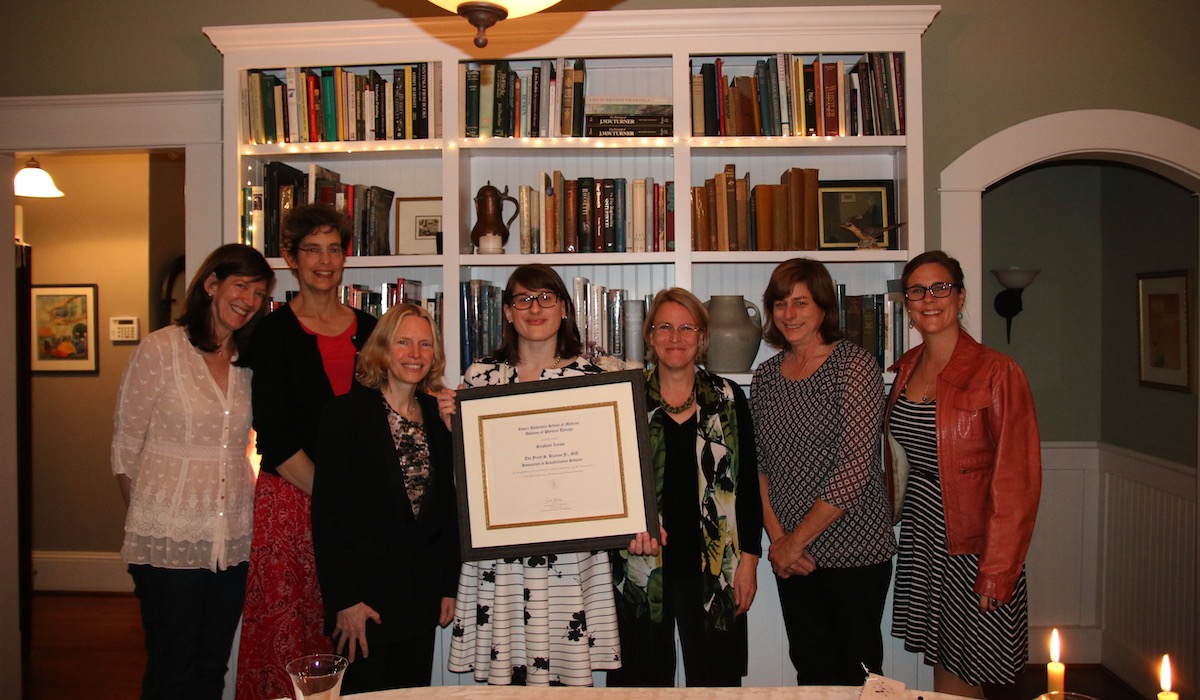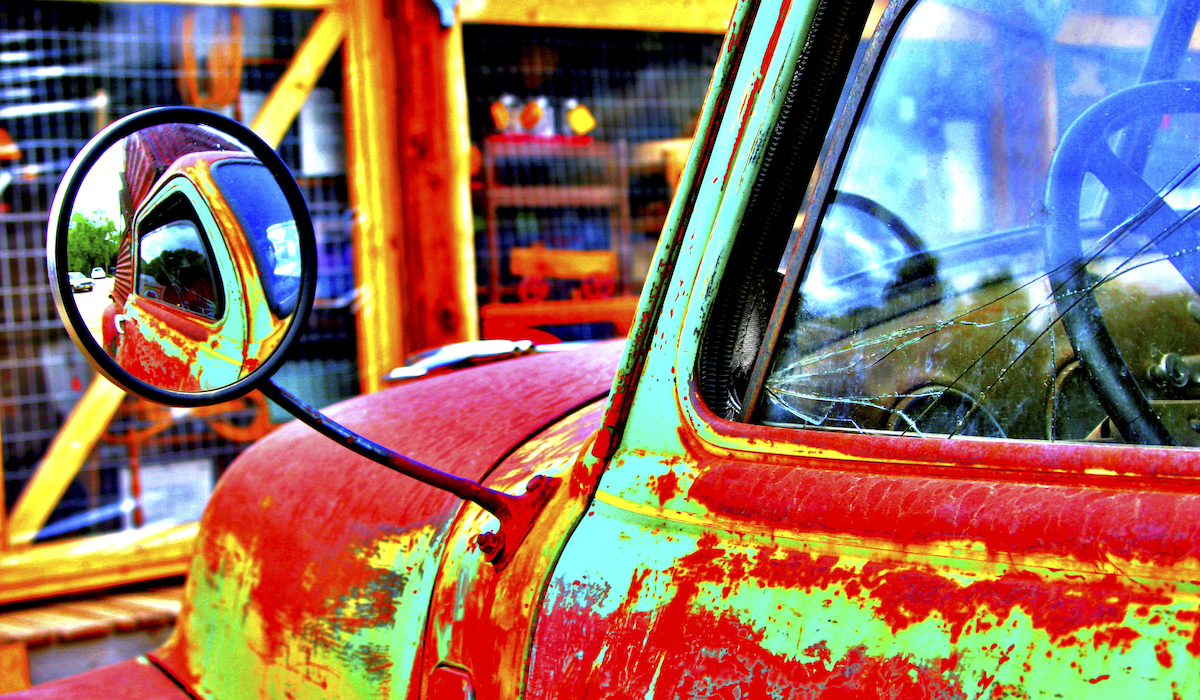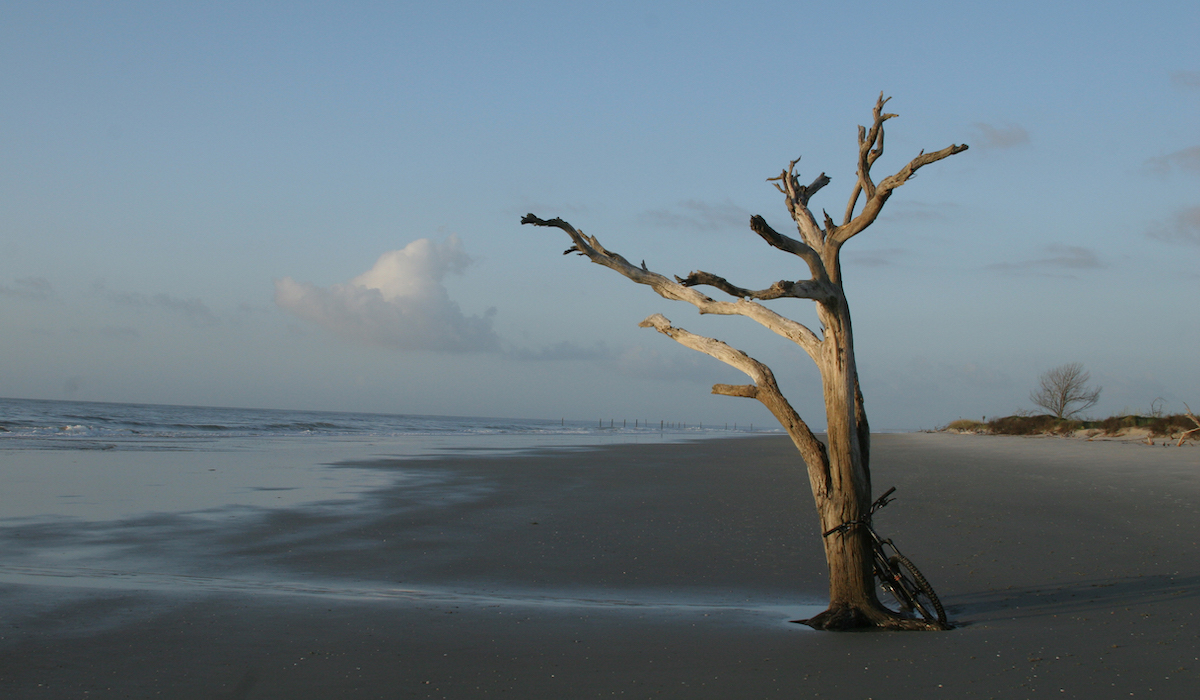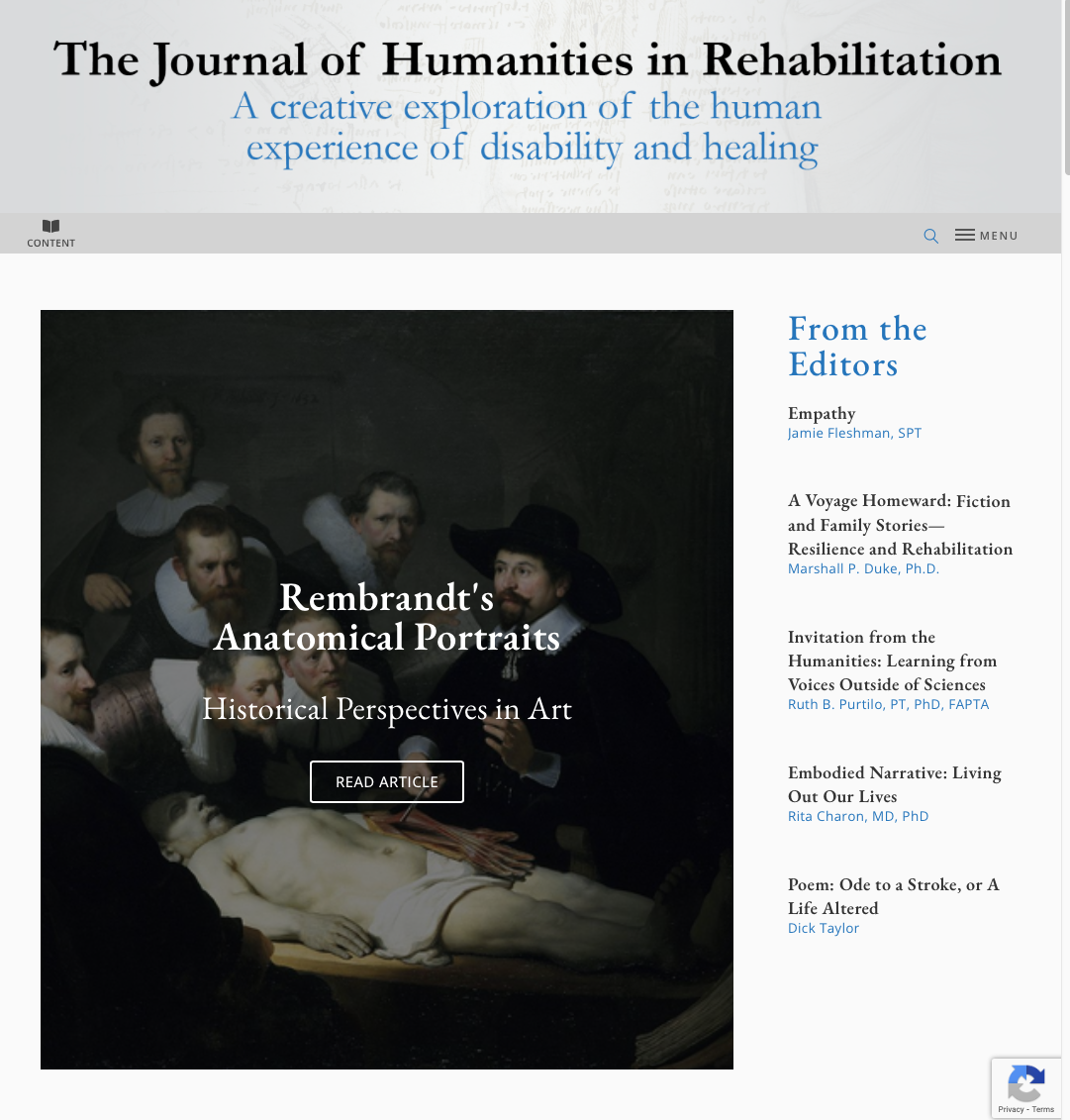It was raining that Tuesday and the University of Virginia (UVA) junior didn’t know if she felt all that motivated to go to the internship fair taking place that evening.
“Choosing to go changed my life,” says Sarah Blanton, professor in the Department of Rehabilitation Medicine, founding editor of the Journal of Humanities in Rehabilitation and Fellow of the National Academy of Practice in Physical Therapy.
A biology major at UVA, Blanton had determined that she did not want to attend medical school. At the internship fair, Blanton did two things of consequence: she signed up for a physical therapy (PT)/occupational therapy (OT) internship and then glanced over at the hospice table.
It was deserted. “Nobody was stopping by there. But I was willing to know more, having grown up with dinner-table conversations around hospice,” Blanton says.
The child of a general surgeon father and nurse mother, Blanton watched her mother help start the first hospice program in Bristol, Tennessee. Much later, as her mother succumbed to lung cancer, she lived out her final days there, with the facility naming both a room and scholarship in her honor. “And while my father was a general surgeon,” Blanton notes, “he was called upon to do a lot of palliative care by virtue of essentially serving as the primary care provider for so many patients.”
That hospice internship “led me to PT,” Blanton says. “I was just a volunteer, but I would sit with patients and their families. You are so busy in your fourth year of college, but when I was with those patients, everything fell away and I was never more fully present than in those moments. That was when I thought: I want work that does this. It grounded me and always felt like a sacred place.”
While at UVA, Blanton was leaving a photography class and in a “deep discussion about — what else? — death and dying” and did not see the car approaching that would graze her, tearing the meniscus in her right knee.
That was her first patient experience of physical therapy, but there would be more — each one incredibly instructive to the healer she would become. Two years into her professional practice, she hurt her back, which would continue to require intermittent therapy.
The country mouse makes a home in Atlanta
Blanton went on to earn a master’s and doctorate of physical therapy at Emory, but for a number of years, Atlanta did not feel like home. Raised on South Holston Lake in Upper East Tennessee — a reservoir cradled in the Appalachian Mountains — Blanton had always reveled in the peace and spiritual uplift the area provided. The beauty she saw in those spaces inspired her to become an award-winning photographer.
“I love so many different geographies, but we tend to come back to where we have that sense of place and belonging,” she says.
As she celebrates 34 years at Emory, first as a student and then as a faculty member, Blanton observes: “I have been in Atlanta longer than I have been anywhere, but I still feel like a country mouse, having grown up in a small town.”
In 2014, for the On Being project, Blanton wrote an essay about South Holston Lake titled “Thin Places and the Transforming Presence of Beauty,” which also features her photography.
She quotes the former Harvard theologian Peter Gomes, who explained the concept of “thin places”: “There is in Celtic mythology the notion of ‘thin places’ in the universe where the visible and the invisible world come into their closest proximity. Mountains and rivers are particularly favored as thin places. … But perhaps the ultimate of these thin places in the human condition are the experiences people are likely to have as they encounter suffering, joy and mystery.”
Throughout her career and life, Blanton has embraced these thin places. Neurorehabilitation, her specialty within PT, allows her to express the values — gratitude, curiosity, kindness, sincerity in listening and willingness to be vulnerable — that have always guided her.
“Neurorehabilitation is a deep spiritual place where you are meeting people in their times of vulnerability, and you find them so authentic as you accompany them on that journey. It is very much a privilege. Walking down the hall in Emory’s rehabilitation hospital, I would always remind myself that everyone in these rooms is someone whose life has been changed forever and how quickly that can happen to any of us,” she says.
Beyond having been a PT patient herself, she came to know how it feels to be a family member of someone undergoing therapy. Later in her father’s life, he needed spinal surgery, which Blanton arranged for in Atlanta. During the surgery, he suffered a stroke and was in rehabilitation for a month.
“My caregiving work was shaped by my clinical experience, and the former was really shaped by being a carepartner for my dad — working with my family and recognizing how many people never really asked us how we were doing. That is why my goal in research has always been to foster family-integrated care,” Blanton says.
According to the scholarly literature, those with disabilities represent the world’s largest minority group. At every turn, Blanton has fought against a historically ableist view of disability and rehabilitation, believing that “it is through the engagement of the humanities that we truly transform the practice of physical therapy.”
Says Marie Johanson, professor of rehabilitation medicine, “Leveraging her clinical expertise in neurologic physical therapy with her own visual artistry, Sarah is a pioneer in the field of humanities in rehabilitation. Her work has elevated the Division of Physical Therapy, Emory’s School of Medicine and the university internationally by insisting that integrating the lens of humanities into health care is not a nicety but a necessity for the ethical care of patients.”

The journal awards the scholarship named for Blanton’s father at playwright Maggie Edson’s home. (L to R) Linda Merrill, Emory art history professor; Edson; Laura Otis, Emory English professor emerita; 2016 recipient Stephanie Larson; Sarah Blanton; Jamie Larson; and Emma Goldberg, the physical therapy graduate student who won in 2017.
Tirelessly pursuing a better lived experience for patients
After earning her master’s in PT in 1992, Blanton worked at Emory Rehabilitation Hospital from 1992-2000, at which point a tantalizing offer came from Steven Wolf, now professor emeritus of rehabilitation medicine, a towering figure in the field. Groundbreaking research in neuroplasticity revealed a greater understanding of how the brain recovers after a stroke. Wolf asked Blanton to join a landmark study of constraint-induced movement therapy; this was to be the first multisite clinical trial in stroke rehabilitation.
The idea behind constraint-induced movement therapy was to restrain, by the use of a soft mitt, the stronger arm following stroke so patients would be forced to use the weaker arm for daily activities. “To that point, it was possible to think of PT as a kind of black box, highly dependent on personalized care. What was so exciting was the possibility of creating a standardized protocol that would be easy to evaluate,” Blanton says.
Nonetheless, leaving her work as a clinician at Emory Rehabilitation Hospital was “a big deal for me because I loved being with patients,” Blanton reflects. She made that devotion to patients part of the terms on which she joined, signing on as a research coordinator to help with patient recruitment and to learn how to adapt the protocol to the clinic. As interest in constraint-induced therapy grew, Blanton and Wolf joined forces to offer instructional courses internationally.
All told, Blanton would earn her doctorate of physical therapy in 1994 and spend six years with the study, then go on to become a Division of Physical Therapy faculty member in 2006. Reflecting on what she learned in the study, Blanton conceived an avenue for her own research.
“What if I build upon the strategies I used with family members and make it a more structured intervention?” she wondered. “I could teach family members about the principles of neuroplasticity. I also could guide them to what are called ‘autonomy-supportive’ language strategies — that is, using language to help someone stay motivated.”
To blunt what Blanton terms the “particularly pernicious impact of stroke on approximately 4.8 million survivors in the U.S. who require assistance from often untrained and ill-prepared family members,” she developed a theory-based, family-centered innovation called Carepartner and Collaborative Integrated Therapy (CARE-CITE).
Employing an interprofessional team that combines findings from rehabilitation therapy and nursing research, CARE-CITE is designed to enhance the therapeutic process by positively engaging “carepartners”— a term Blanton chose instead of “caregiver” to more accurately reflect the collaborative role she recommends for family members in the home setting.
CARE-CITE guides the carepartner in collaborative goal setting and providing autonomy support for the stroke survivor in order to promote motivation and creative problem-solving to improve arm and hand function.
“We theorize that improving self-management will lead to improvements in both carepartner and stroke survivor health outcomes. This family-centered intervention is a key advancement, moving the rehabilitation field toward stroke care that effectively addresses both survivor and carepartner needs,” Blanton says.
Gail Jensen, a professor of physical therapy at Creighton University, recalls meeting Blanton more than 10 years ago and finding herself “so impressed with not only Sarah’s clinical expertise but the depth of her understanding and continued exploration of the lived experiences of her patients.”
In 2018, through Jensen’s advocacy and that of other admirers, Blanton was awarded the American Physical Therapy Association’s Societal Impact Award. The honor is reserved for “individuals who exemplify the compassionate nature of the physical therapy profession by exhibiting a distinguished commitment toward philanthropic initiatives, raising public awareness on key societal issues and demonstrating how physical therapy can be applied to address these issues.”

This shot of an old truck in Taos, New Mexico, caught Blanton’s eye; it placed third in the 2010 Emory Arts Competition.
Celebrating the arts in the sciences: a family tradition
An abiding joy of Blanton’s life has been the creativity she has encountered — and engendered.
“The appreciation of the arts and humanities in our family was always so rich,” Blanton recalls, and credits her father “for his humanistic approach to patient care and compassion toward others. His deep knowledge of literature, poetry, religion and music infused his work and his relationship with his patients.”
Further inspiration came from Blanton’s high school biology teacher, who not only kindled her lifelong commitment to the discipline but also taught her to use a darkroom. In her senior year, her photography portfolio earned a Scholastic Art & Writing Award, one of the oldest arts competitions in the country for high schoolers. It puts Blanton in good company: Stephen King and other famous artists have won the award over the years.
And she has never stopped sharing how she sees the world. In 2010, a photograph Blanton shot — “Through a Glass Darkly” — received third place in the Emory Arts Competition.
“That Scholastic Art & Writing award gave me a sense of self-efficacy. My dad was a prominent figure in Bristol, a Renaissance man. This was one way that I was able to carve out my own unique identity,” Blanton observes.
It should be no surprise that this same word surfaces when commentators describe Blanton’s impact. “Sarah is truly ‘renaissance’ — she brings our worlds together better than any of us. She is a master clinician, a competent clinical researcher and an extraordinary educator who is able to engage students in much-needed deeper reflection about their learning,” says Jensen.
Blanton’s most groundbreaking project to date, the Journal of Humanities in Rehabilitation (JHR), is in part a valentine to her father.

A treasured space, and one featured frequently in Blanton’s photography, is South Holston Lake, where she was raised.
Bringing to life the Journal of Humanities in Rehabilitation
In partnership with the Emory Center for Digital Scholarship (ECDS), Blanton in 2014 established the JHR — the first peer-reviewed, interdisciplinary journal dedicated to the integration of humanities in rehabilitation sciences and the first rehabilitation journal to collaborate with international disability scholars.
Blanton saw the journal as “occupying the powerful and transformative intersection of arts and sciences fully in alignment with the values expressed in the One Emory Strategic Framework and the Emory Initiative for Arts and Humanistic Inquiry.”
Disability rights activists coined the slogan “Nothing about us without us” during the 1990s. Supporting this goal, the JHR is a rare scientific journal that provides a platform for the co-creation of content with and for people with disabilities, their carepartners and the rehabilitation community.
“With the JHR,” says Jensen, a member of the editorial advisory board, “Sarah brings forward, with great respect, the voices of patients, families and caregivers. I do not know of another journal that does that. For those of us in PT, the journal is our ‘north star’ in providing a much-needed understanding of the human condition; it also makes us better at working together for the well-being of our patients.”
By adopting a transdisciplinary approach to integrate humanities, disability studies and rehabilitation, along with fostering collaborative community partnerships, the JHR addresses the complex and pervasive health inequities faced by the disability community.
“Our next goal,” says Blanton, “is to find funding to enable the journal to be the first publication to engage members from the disability community as editorial staff, providing an opportunity for decision-making and power-sharing to help shape content, evaluate accessibility and broaden readership to more diverse communities.”
A rich outlet for students and colleagues
“JHR is a perfect example of the kind of interdisciplinary and public scholarship that we love to support,” says Alex Cors, digital scholarship specialist at ECDS. “By bringing together scholars and practitioners from different fields and making their work accessible for a broad audience through open-access web publishing, we can help Sarah and her amazing team get their work out to as many interested readers as possible.”
The journal’s collaboration with ECDS is ongoing, with students being prime beneficiaries. Normally, two students work together, one coming from physical therapy and one from ECDS.
“The physical therapy students are subject matter experts whose insights are invaluable. From our side, we train the physical therapy students on all aspects of digital scholarship and digital publishing,” Cors says. “We have had great experiences with this model, and Sarah is committed to continuing this exchange of knowledge and skills.”
Stephanie Larson earned her doctorate in English and completed a certificate in bioethics here. She sought work on the JHR after “reading the journal’s incredibly impressive inaugural issue.” Still early in her doctoral training when she and Blanton first met, Larson confesses to being a bit nervous.
“Sarah treated me as though she were meeting a friend and colleague, and the invaluable mentorship that followed has exemplified the humanistic values she has spearheaded,” Larson says. For Blanton, the praise must flow both ways because, as she notes, “Stephanie had a significant role in shaping the journal.”
The Frank S. Blanton Jr., MD Humanities in Rehabilitation Scholarship Fund was established in 2016 in honor of Blanton’s father, and the scholarship has been awarded to eight students, Larson among them.
“Although we never met, I feel I have come to know Sarah’s father through the life Sarah has led as a mentor, researcher, clinician and advocate for the humanities. What’s remarkable about the scholarship is that it isn’t just a title or award but an invitation to a community, one that for me has led to lifelong connections.”
Sarah Caston knows Blanton as a former student, now colleague, and cites “the tremendous impact she has had on me, both personally and professionally. She is just one of those rare humans who, along with her brilliance and creativity, possesses a genuinely kind and humble spirit.”
An assistant professor of rehabilitation medicine and assistant director of clinical education, Caston is currently the journal’s narrative section editor and says of this shared endeavor: “JHR reflects the alchemy of Sarah’s vision and heart for many facets of the human experience. Its articles, reflections and resources appear in health education programs and clinical settings across the nation. This work will undoubtedly send ripples of creativity to, and create valuable impact for, future generations.”

Blanton captured this image at Debordieu Beach in South Carolina — a spot her family would visit each summer. She and her brother fell under the spell of this particular tree, which she would photograph on every trip.
Staying — and still striving for disability justice
Though occasionally daydreaming about a return to South Holston Lake or the possible joy of life in Boulder, Colorado, or Asheville, North Carolina, Blanton stays in the big city because of the strength of her relationships with colleagues, students, patients and family members.
“I have flourished at Emory in response to all those who taught me the value of fierce moral courage, visionary leadership, compassion-based clinical care and novel, transdisciplinary ways of thinking. While the academy is often criticized for operating in silos, I have found that a sincere pursuit of humanism through my service, teaching and research has allowed me to transcend those barriers and build collaborative relationships across the university,” she says.
Above all else, she feels gratitude. “As we are working toward being healers, we are being healed ourselves,” Blanton notes.
Concludes her colleague Marie Johanson: “Sarah brings compassion, a finely tuned ear, humility, humor and intellect, and she reminds us that we are both students and teachers on our journeys through life.”
More on the Journal of Humanities in Rehabilitation
|

